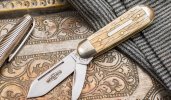I see both sides. This post may get me some people upset at me, but
with a thread entitled, to ivory or not to ivory, I guess this is the place to speak.
I love ivory covered knives. And
I often think I should not have them. I think that after micarta, its one of the most functional cover materials. Softer than bone, harder than wood, beautiful
whats not to like? Okay, on to the politics. On the one hand, I think its too simplistic to say, well, this elephant was killed 50 years ago, before the ban, so no harm, no foul. The issue here is not that ivory of any kind (or date) is inherently evil (some think it should be socially engineered as such
and maybe for good reason
Ill get there). The issue is one of a global ivory market. Demand for ivory harvested 50 years ago is not really distinct from demand for ivory in general . People just want ivory. Economist would argue (and do!) that when we buy ivoryeven pre-ban, ethically harvested ivorywe are increasing the overall global demand for this material. And an increased global demand for ivory will result in the death of more elephants this very day. I know
it sound dramatic. But it sort of is dramatic. Some experts estimate that up to 100 African elephants are killed each day. Supposedly less than 500,000 African Elephants currently exist (as opposed to approximately 4 million in the early 1900s).
But I can see the other side, too. For example, my parents have an ivory carving that has been in the family for generations. Personally, I think its really ugly, but its basically half an elephant tusk (!). I always joke (except Im not joking) that when my parents pass, Ill take the carving and use it for knife handles. So if I do that (okay
.WHEN I do that), how does that kill an elephant? Does me repurposing the carving as a hobby kill any more elephants than leaving the same carving as is on the dining room table? Of course is does not. Thats just silly.
Also, there is a certain (responsible and respectful) way of thinking where using ivory is a moral imperative. If an animal dies, no part should go to waste.
But from the aforementioned economists view, the demand, trading, buying and repurposing of ivory increases its value on the global market. We can isolate ourselves (as I did with the anecdote about my parents carving), but its difficult to argue that the global market idea is false. So what to do? This is where people want to create a culture wherein ivory IS inherently evil. It may very well be true that the only way to save the elephants is to make the very possession of elephant ivory a despicable thing, a shameful practice. Furthermore, that way of thinking must also acknowledge that it would be quite a mental feat to value warthog ivory, for example, and not elephant ivory.
This is where mammoth enters. When people say that buying mammoth ivory should be illegal, they are positing that if mammoth ivory is valued, it is virtually impossible NOT to value other ivory (read: elephant ivory) as a byproduct. They are almost certainly correct. And yet
even though I think we can see the point, its simply ridiculous to ban the possession of a fossil. (Perhaps there is a third way
we should all think about this) But the point is that this notion of an interconnected value between different kinds (and dates) of ivory is the motivation behind desires to ban mammothan agenda to make ivory of all kinds a material that no one should actually want to own.
Interestingly, the practice of burning confiscated ivory baffles me. On the one hand, it sends a clear message: poached materials will be destroyed, so why risk it? Well, they risk it for money, I guess. The demand is strong enough that criminals risk it to make money. But would not burning confiscated ivory just increase demand by reducing the global supply? So its a paradoxical practice. Its in interesting to consider how governments burning confiscated ivory might actually be killing elephants by reducing supply and thus increasing demand. (I cant buy a knife because that will increase demand, but they can consume thousands of pounds of the stuff???) But I think their intention is to create a public spectacle by which ivory, as material, is infused with social meaningshame. I think burning confiscated ivory is a discursive practice. There are those who believe that the only way to save elephants is to make ivory into something that is shameful to possess. I am not sure how I feel about that, but I think understanding that it is a conscious attempt to change the discourse surrounding ivory is extremely important.
Im really not trying to argue one way or another about to ivory or not to ivory. Im conflicted about the issue. What I AM saying is that as knife people (or as gun people or musical instrument people), I dont think its acceptable to just say, well, its pre-ban, ethically harvested or well, its been extinct for thousands of years. It may very well be that there are good arguments for the continued use of ivory in knives, but we need to think deeply and make those arguments. And we need to do it in dialogue with these more complicated issues of global markets and the interconnected value of various types of ivory. Otherwise, our arguments arent really arguments.
(my longest post EVER. Sorry)





